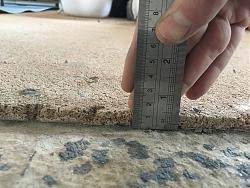Flooring materials have evolved significantly over the centuries, reflecting advancements in technology, design preferences, and practicality. One such material that gained popularity in the early 20th century is magnesite flooring, a unique mixture of magnesium oxide, cement, and other additives.
While magnesite flooring boasted certain advantages, its drawbacks have become increasingly apparent over time, necessitating its removal. Remedial engineers play a crucial role in addressing the challenges posed by magnesite flooring.
Disadvantages of Magnesite Flooring:
While magnesite flooring had its advantages, it didn’t take long for its disadvantages to become apparent. Over time, several significant issues arose, tarnishing its reputation:
Susceptibility to Cracking:
One of the most prominent drawbacks of magnesite flooring is its tendency to develop cracks.
These cracks can be caused by a range of factors, including shifting foundations, temperature fluctuations, and heavy foot traffic.
As the cracks deepen and widen, they cause concrete spalling to the concrete slab which can compromise the structural integrity of the flooring.
Moisture and Water Damage:
Magnesite flooring is highly porous, making it susceptible to water absorption. Moisture infiltration can lead to swelling, warping, and deterioration of the material. In areas with high humidity or potential water exposure, magnesite flooring can rapidly degrade, leading to costly repairs or replacement.
Lack of Flexibility:
The rigidity of magnesite flooring renders it incapable of accommodating the natural movements of a building’s structure. As buildings settle or experience minor shifts, the inflexible magnesite flooring is prone to cracking and separation from the subfloor.
Maintenance Challenges:
Proper maintenance of magnesite flooring can be demanding. Regular sealing is necessary to mitigate its porous nature, and even with diligent maintenance, the appearance of stains and discoloration is common over time.
The Imperative for Removal and the Role of Remedial Engineers
Given the array of challenges associated with magnesite flooring, its removal has become a priority in many cases.
Remedial engineers can play a vital role in addressing the issues stemming from magnesite flooring:
Comprehensive Assessment: Remedial engineers conduct thorough assessments of the existing magnesite flooring, identifying the extent of damage, underlying causes, and potential risks. This assessment informs the removal strategy and/or subsequent restoration steps.
Safe Removal Procedures: The removal of magnesite flooring requires careful planning and execution to avoid further damage to the underlying structure. Remedial engineers employ techniques that minimise dust, debris, and disruption to the building occupants.
Substrate Preparation: After magnesite flooring removal, remedial engineers prepare the substrate for the installation of a new flooring system. This step is crucial to ensure proper adhesion and longevity of the replacement material.
Alternative Flooring Solutions: Remedial engineers collaborate with architects and designers to select suitable replacement flooring materials. Modern alternatives such as epoxy coatings, terrazzo, or reinforced concrete offer durability, aesthetics, and resistance to the issues associated with magnesite flooring.
Long-Term Durability: Remedial engineers focus on creating flooring solutions that not only address immediate concerns but also promote long-term durability. Through careful material selection and expert installation, they contribute to the longevity of the new flooring system.
In conclusion, magnesite flooring, while historically significant, has fallen out of favour due to its inherent disadvantages and susceptibility to various issues. Cracking, moisture damage, inflexibility, and maintenance challenges have rendered it an impractical choice for modern structures.
As a result, the removal of magnesite flooring has become a necessity in many cases. Remedial engineers, armed with their expertise in structural rehabilitation, are instrumental in executing safe removal processes and recommending appropriate alternative flooring solutions. They contribute to the preservation, functionality, and aesthetic appeal of structures while ensuring the safety and satisfaction of occupants.

